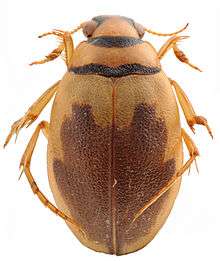Hygrobia
Hygrobia is a genus of aquatic beetles native to Europe, North Africa, China and Australia. It is the only genus in the family Hygrobiidae, also known as the Paelobiidae.[1] These are known commonly as squeak beetles[2] or screech-beetles.[3]
| Hygrobia | |
|---|---|
 | |
| Hygrobia hermanni | |
| Scientific classification | |
| Kingdom: | |
| Phylum: | |
| Class: | |
| Order: | |
| Suborder: | |
| Family: | Hygrobiidae |
| Genus: | Hygrobia Latreille, 1804 |
| Species | |
| |
There are six known living species, with a highly disjunct distribution, and one extinct species, Hygrobia cretzschmari.
Biology
All species occur in lowland areas [4] and are mainly found in stagnant water.[5] They live in the mud, silt, and detritus of ponds.[4]
None of the species occur in sympatry, except for H. nigra and H. australasiae in south-eastern Australia.[6]
Both adults and larvae are predators, specialized on oligochaet worms. The adults feed for as long as 30 min, coming to the surface very briefly to renew the air-supply.[7]
Adults are able to stridulate, producing an audible sound,[8] which is why they are called squeak or screech beetles.
Morphology
The body length ranges from 8.0 to 11.0 mm. Compound eyes are present, not divided into ventral and dorsal portions, strongly protruding. Labrum is short and transverse. The antennae are filiform, almost glabrous, with 11 segments.[5]
Phylogeny and evolution
The monophyly of the family is not in doubt.[6]
Hygrobiidae is thought to be the sister group to a clade comprising Dytiscidae (diving beetles), Amphizoidae (trout stream beetles) and Aspidytidae (cliff beetles), based on DNA sequence data.[6][9][10]
Regarding the relationships among the species of Hygrobia, a recent phylogenetic analysis suggested a sister group relationship between H. hermanni and a clade formed by the Australian species, with H. nigra sister to H. australasiae.[6]
Hygrobiidae probably diverged from other Hydradephagan clades around the time of the initial breakup of Pangea. The split between today’s Palearctic and Australian clades occurred later, possibly in the middle Mesozoic, by dispersal events.[6]
Species diversity and distribution
Hygrobia australasiae (Clark, 1862) - Australia
Hygrobia davidi Bedel, 1883 - Jiangxi, southeastern China
Hygrobia hermanni (Fabricius, 1775) - Europe, northern Africa (Morocco, Algeria and Tunisia), and Israel
Hygrobia maculata Britton, 1981 - Australia
Hygrobia nigra (Clark, 1862) - Australia
Hygrobia wattsi Hendrich, 2001 - Australia
Family name
There has been a controversy associated with deciding which is the valid family name of squeak beetles: Hygrobiidae or Paelobiidae.[1] Paelobiidae has priority over Hygrobiidae, but the latter name was until recently much more widely used.[11]
References
- Nilsson, A. N. (2006). Which name is valid – Hygrobiidae or Paelobiidae? Latissimus 21 37-39.
- Michat, M. C., et al. (2014). Description of the third instar of Hygrobia nigra (Clark, 1862) (Coleoptera: Paelobiidae), with a key for the identification of mature larvae of Hygrobia Latreille, 1804 and phylogenetic analysis. Zootaxa 3827(3) 318-30.
- Watson, L. and M. J. Dallwitz. Hygrobia. British Insects: The Families of Coleoptera.
- Dettner, K. (2005). Noteridae. Handbook of Zoology, 4, 72-90.
- Holmen, M. (1987). Family Hygrobiidae. The aquatic Adephaga (Coleoptera) of Fennoscandia and Denmark. Brill, 136-142.
- Hawlitschek, O., Hendrich, L., & Balke, M. (2012). Molecular phylogeny of the squeak beetles, a family with disjunct Palearctic-Australian range. Molecular Phylogenetics and Evolution, 62(1), 550-554.
- Balfour‐Browne, F. (1922, April). 5. The Life‐History of the Water‐Beetle Pelobius tardus Herbst. In Proceedings of the Zoological Society of London (Vol. 92, No. 1, pp. 79-97). Blackwell Publishing Ltd.
- Jäch, M. (1995). Hygrobiidae (Coleoptera). In: Jäch, M.A., Ji, L. (Eds.), Water Beetles of China, vol. I. Zoologisch-Botanische Gesellschaft in Österreich und Wiener Coleopterologenverein, Wien, pp. 109–110.
- Balke, M., Ribera, I., & Beutel, R. G. (2005). The systematic position of Aspidytidae, the diversification of Dytiscoidea (Coleoptera, Adephaga) and the phylogenetic signal of third codon positions. Journal of Zoological Systematics and Evolutionary Research, 43(3), 223-242.
- Balke, M., Ribera, I., Beutel, R., Viloria, A., Garcia, M., & Vogler, A. P. (2008). Systematic placement of the recently discovered beetle family Meruidae (Coleoptera: Dytiscoidea) based on molecular data. Zoologica Scripta, 37(6), 647-650.
- Lawrence, J. F., & Newton, A. F. (1995). Families and subfamilies of Coleoptera with selected genera, notes, references and data on family-group names.[pp. 779-1006].[in:] Biology, Phylogeny and Classification of Coleoptera. Papers celebrating the 80th birthday of Prof. Roy A. Museum i Instyut Zoologii PAN, Warzawa.
External links
- Hygrobia. Fauna Europaea.
| Wikimedia Commons has media related to Hygrobia. |
| Wikispecies has information related to Hygrobia |